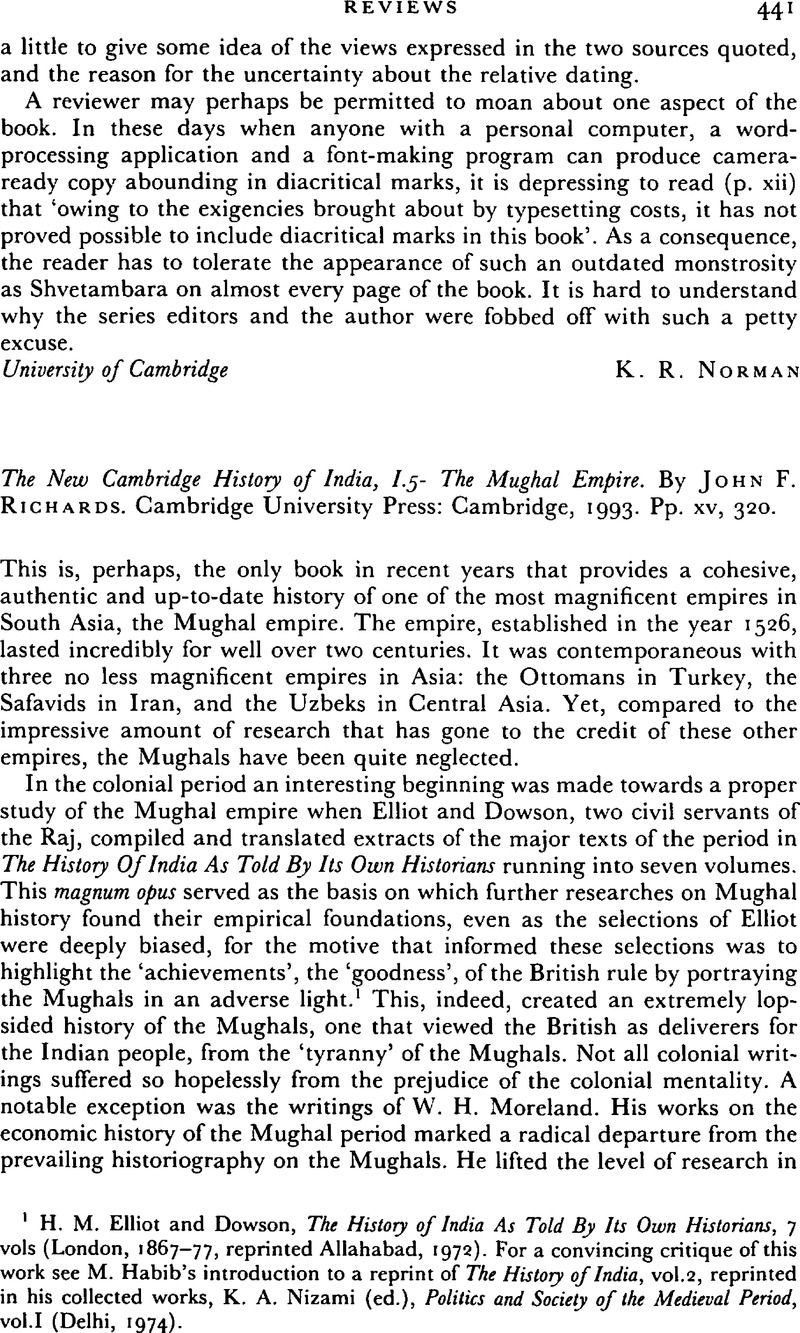No CrossRef data available.
Published online by Cambridge University Press: 28 November 2008

1 Elliot, H. M. and Dowson, , The History of India As Told By Its Own Historians, 7 vols (London, 1867–1877, reprinted Allahabad, 1972).Google Scholar For a convincing critique of this work see Habib's, M. introduction to a reprint of The History of India, vol.2, reprinted in his collected works, Nizami, K. A. (ed.), Politics and Society of the Medieval Period, vol.1 (Delhi, 1974).Google Scholar
2 Moreland's major works on the Mughal empire are: India at the Death of Akbar (London, 1920)Google Scholarand From Akbar To Aurangzeb: A Study in Indian Economic History, (London, 1923).Google Scholar Moreland's writings provoked an almost simultaneous rebuttal by the nationalist economic historians. Brij Narain sought to present a very different picture of the Mughal economy from that of Moreland in his Indian Economic Life: Past and Present (London, 1929).Google ScholarMukherji, Radhakumal published an article in the Journal of the U. P. Historical Society, xiv, 1 (1931) that was later to be published in the form of a book called The Economic History of India, 1600–1800, wherein he argued that the real wages and standards of living in Mughal India were higher than in the colonial period.Google Scholar
3 See, for example, Sarkar, Jadunath, History of Aurangzeb, 5 vols (Calcutta, 1914–1924);Google ScholarPrasad, Beni, History of Jahangir (London, 1922);Google Scholarand Saksena, Banarsi Prasad, History of Shahjahan of Dihli (Allahabad, 1932).Google Scholar
4 Not all the works of the historians of the ‘Aligarh school’ can be cited here. I provide below a small selection as illustrative examples: Habib, Irfan, The Agrarian System of Mughal India (Bombay, 1963);Google Scholaridem, An Atlas of the Mughal Empire (Delhi, 1982);Google ScholarChandra, Satish, Parties and Politics at the Mughal Court, 1707–1740 (Aligarh, 1959);Google ScholarKhan, I. A., Mirza Kamran (Bombay, 1964);Google ScholarAli, M. Athar, The Mughal Nobility Under Aurangzeb (Aligarh, 1966);Google Scholaridem, The Apparatus of Empire (Delhi, 1985);Google ScholarSiddiqi, Noman A., Land Revenue Administration under the Mughals, 1700–1750 (Bombay, 1973);Google ScholarHasan, S. Nurul, Thoughts on the Agrarian Relations in Mughal India (Delhi, 1973)Google Scholarand Moosvi, Shireen, The Economy of the Mughal Empire c. 1515 (Delhi, 1987).Google Scholar
5 Certainly, exceptions do exist, as for example, Richards', J. F.Mughal Administration in Golkunda (Oxford, 1975).Google Scholar Another exceptional work is Richards, J. F. (ed.), The Imperial Monetary System of the Mughals (Delhi, 1987).Google Scholar An encouraging trend can be discerned in two recent works on Mughal history coming from the west: Streusand, Douglas E., The Formation of the Mughal Empire (Delhi, 1989)Google Scholarand Blake, Stephen P., Shahjahanabad: The Sovereign City in Mughal India, 1639–1739 (Cambridge, 1990).Google Scholar
6 The model was introduced in Southall, Aidan, Alur Society (Cambridge, 1956).Google Scholar It was adopted for the Cholas, and later the Vijayanagar empire by Burton Stein see his Peasant State and Society in South India (New Delhi, 1980)Google Scholarand The New Cambridge History of India, vol. I. 2 — Vijayanagar (Cambridge, 1989).Google Scholar
7 Wink, André, Land and Sovereignty in India: Agrarian Society and Politics under the Eighteenth Century Maratha Swarajya (Cambridge, 1986).Google Scholar
8 Blake, Stephen P., ‘The Patrimonial-Bureaucratic Empire of the Mughals’ The Journal of Asian Studies, xxxix, 1 (1979). The theory is also discussed by Blake in Shahjahanabad.Google Scholar
9 Perhaps the clearest exposition is to be found in Ali, M. A., ‘Towards an Interpretation of the Mughal Empire’, The Journal of the Royal Asiatic Society of Great Britain and Ireland, 1 (1978).Google ScholarAlso see idem., ‘The Mughal Polity — A critique of Revisionist Approaches’, Modern Asian Studies, 27, 4 (10. 1993).Google Scholar
10 Cf. Khan, Iqtidar Alam, ‘The Nobility under Akbar and the Development of his Religious Policy, 1560–80’, The Journal of the Royal Asiatic Society of Great Britain and Ireland (1968).Google Scholar
11 See Ali, M. A., ‘Akbar and Islam (1581–1605)’, in Israel, Milton and Wagle, N. K. (eds), Islamic Society and Culture — Essays in Honour of Professor Aziz Ahmad (Delhi, 1983).Google Scholar
12 See Habib, Irfan, ‘The Political Role of Shaikh Ahmad Sirhindi and Shah Waliullah’, Proceedings of the Indian History Congress (1961).Google Scholar